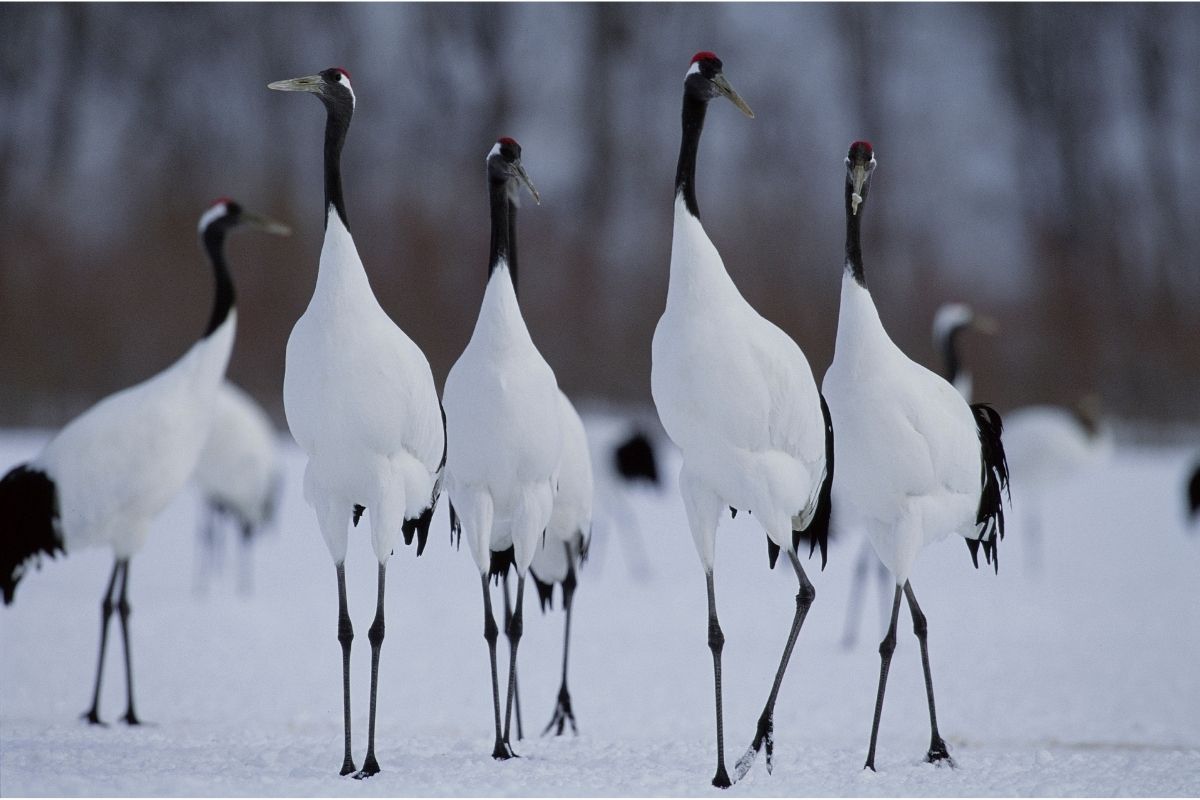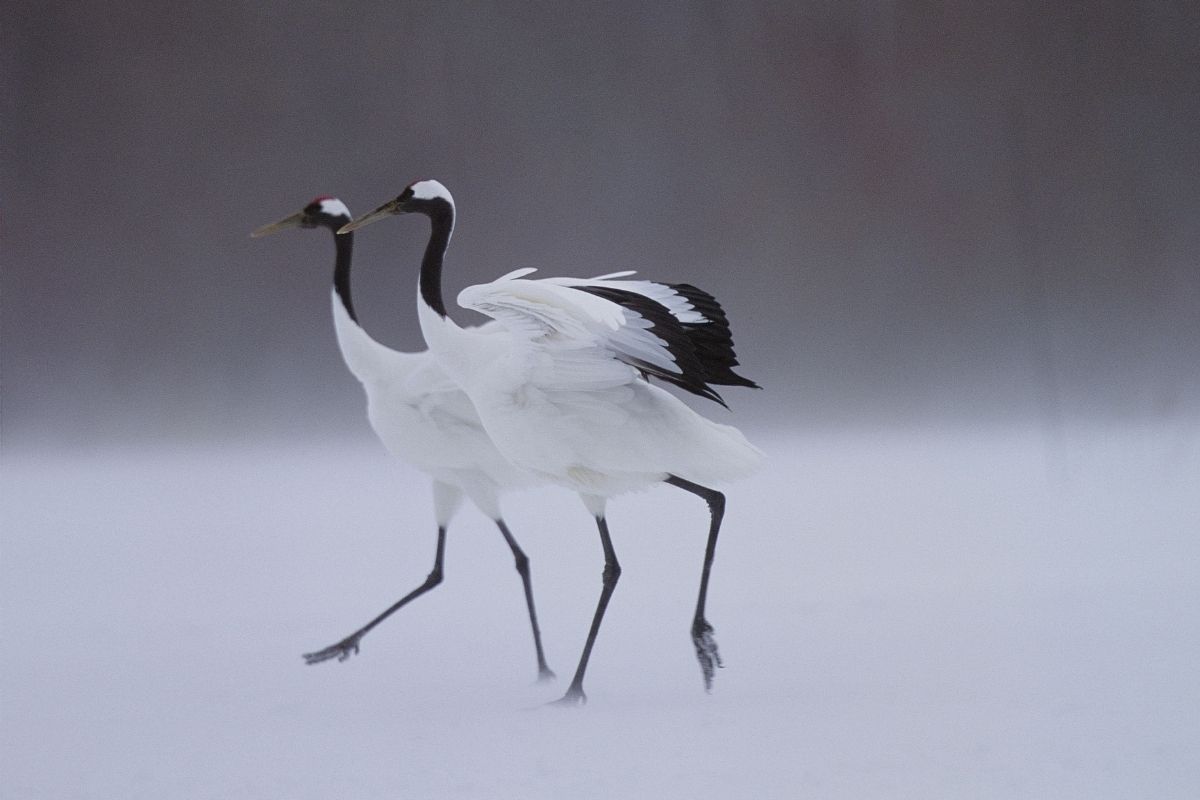Interesting Animal Facts About Cranes
Last Updated on April 9, 2022 by
Cranes are the longest-living birds known on earth. They are large, with long necks and legs. They are monogamous creatures, mating for life.
Furthermore, they live in groups, where they raise their young together, and they migrate from place to place, sometimes over thousands of miles.
They are part of the Gruidae family, a family of long-legged, long-necked, and relatively large birds.
There are 15 different species of cranes, and they are spread over 5 continents.
Cranes have a very distinctive appearance. Their heads are large and round, and their neck is long and slender.
Their body is covered with feathers that can be white or gray-brown. They have long wings that are pointed at the tips. Their tails are also long and narrow.
Cranes eat fish, frogs, snakes, insects, small mammals, and other animals. In fact, cranes are omnivores; they will eat almost anything if it’s available.
Crane Interesting Facts
Cranes are found throughout Africa, Asia, Europe, North America, and Australia. Some of them can live across large regions, whereas others enjoy living in smaller areas.
In nature, cranes are usually seen in pairs or family groups. However, some species form larger flocks.
The largest crane species is the Sarus crane. It can grow up to 5.9 feet tall, has a wingspan of around 8.2 feet in width, and weighs around 17 pounds.
Some people think that cranes look like dinosaurs because of their long necks and tails.
But actually, cranes evolved from prehistoric birds called enantiornithines, among several others.
Cranes are famous for their elaborate courtship rituals. Males perform these dances by spreading their wings and moving them up and down.
Females watch nearby and choose which male they want to mate with.
Cranes are social birds. They live in families or flocks. When a crane dies, its relatives may gather around the corpse and mourn.
These creatures can fly well, but most prefer to walk along the ground. Some species use their long legs to run quickly when danger threatens.
Where Do Cranes live?
Cranes are native to tropical and subtropical regions. Most cranes live near water, although some species are adapted to dry habitats.

They live in many countries, and you are likely to find different species of them in different parts of the world.
For example, Gray-crowned cranes are likely to be found in southern and eastern Africa.
Demoiselle cranes are beautiful in appearance, and they enjoy the north, living in Eurasia, beginning at the Black Sea, and through to China.
Blue cranes are found in South Africa, and they are known as the national bird of that country.
Siberian cranes live in Russia, and they can be seen in India and China during the migration period.
Brolga cranes are the cranes you are likely to see in Australia and New Guinea. These are the heaviest cranes you’ll come across, weighing up to 18 pounds.
How Do Cranes Get Their Food?
Cranes are omnivores, meaning they eat both animals and plants. They are opportunistic feeders, which means they can adjust their nutrition to the season.
They enjoy eating leaves, berries, and seeds, and when they are in wet environments they’ll eat mollusks, roots, and rhizomes.
When they are eating plants, they will dig their way through the soil and make a hole to find food. When they want to eat animals, they hunt by moving very slowly, proceeding with caution.
How Do Cranes Reproduce?
Cranes reproduce through sexual reproduction. A female crane lays eggs in a nest. After she finishes laying, she leaves the nest.
She returns several days later to feed her young.
After she feeds her chicks, she goes back to the nest to lay another batch of eggs. The mother then takes care of her children until they’re ready to leave the nest.
When the babies hatch, they have sharp claws and teeth. They stay close to their mothers for protection.
Their first meal is worms, beetles, snails, and other small invertebrates.
When the babies grow bigger, they start eating insects, frogs, fish, snakes, lizards, mice, and even small birds.
How Do They Communicate?
They communicate using sounds and gestures. For example, a male will make a low rumbling noise if he wants his partner to move closer.
If he’s not interested, he’ll just grunt.
If he’s really interested, he’ll make a louder sound. He’ll also spread his wings out wide and flap them slowly.
If he sees something interesting, he’ll open his beak and let out a loud whistle.
How Fast Can A Crane fly?
When they migrate, cranes can fly at speeds of up to 80 kilometers per hour! If they’re lucky enough to have tailwinds helping them out, then they can reach around 100 kph.
During migration, they will fly for around 7 hours at a time, flying distances of around 400 kilometers.
What is most interesting about them is the way they fly. Due to their large wingspan, they don’t need to flap their wings all too often.
They also look for thermals in the air. These are heated areas of air that rise from the ground.
The cranes will then circle this pocket of air until they reach a good attitude, and then they will glide in their desired direction.
They will descend slowly, and when they reach another thermal, they will repeat the process.
When And Where Do Cranes Migrate?
Migration is when animals will travel to a different habitat during different seasons in search of appropriate food, water, or for reproduction reasons.
Different kinds of cranes embark on different kinds of migration routines, but in general, cranes can cover large distances when they migrate, reaching around 200 miles in one day!
The cranes that migrate the most are the Lesser Sandhill Cranes. They migrate between their wintering and breeding grounds and cover long distances.
They will likely travel between northeast Siberia and northern Mexico.
Demoiselle Cranes will travel over the Himalayas during their migration period and will reach altitudes of around 26000 feet in order to make it to their wintering part of the world in India.
Sarus Cranes in Southeast Asia will migrate from northern Cambodia to Vietnam- to the Mekong River basin to spend their winter.
Despite these great distances, there are some cranes that do not travel too far during migration. Blue, Crowned, and Wattled Cranes live in Africa, and they will travel seasonally within Africa.
When it comes to crane chicks, they will experience their first migration with their parents.
They will be taught the route first, before completing it on their own when they are older.
Unfortunately, migration periods are the most dangerous times for cranes, as they are susceptible to shootings, and habitat loss due to flyways.
Cranes will usually migrate twice a year – once in the fall, and once in the spring.
Ecology And Conservation
Unfortunately, these beautiful birds do face certain threats. They are susceptible to habitat destruction and hunting, especially Sandhill cranes who nest in marshes.
These marshes have been drained, meaning their nests have been destroyed.
All species of cranes are protected in America by an international agreement. In Florida, Sandhill cranes are known as a threatened species.
Crane Symbolism And Meaning
Cranes symbolize strength, power, and beauty. The symbolism behind cranes has changed throughout history, but today, they are still used in many cultures to represent strength, courage, and perseverance.
Elegance
Cranes are known to represent elegance. This is due to the way they carry themselves. They are naturally graceful and elegant.
Focus And Balance
When cranes want to hunt fish, they will stand on one leg and wait for them to come close, so they can catch and eat them.
They can balance on one leg for hours, meaning they are very focused, poised, and well-balanced birds.
Loyalty
As mentioned already in this article, when cranes mate, they mate for life. They are tremendously loyal to one another, and when their mate dies, they experience a lot of pain.
Courage
Cranes are also known to represent courage. This is because they are strong creatures, and they can withstand harsh weather conditions.
They are able to endure hardships, and they are also extremely courageous animals.
Strength
Another reason why cranes are symbolic of strength is because they are large birds.
Their bodies are big enough to support their weight, and they are capable of lifting heavy objects.
Beauty
The beauty of cranes is undeniable. They are graceful, majestic, and powerful looking. They are also very intelligent, which makes them even more attractive.
Wisdom
The wisdom of cranes is also something that cannot be denied. They are wise, and they know how to survive in difficult situations.
They are very smart, and they understand what is happening around them.
Fertility
Cranes are considered to be fertility symbols. This is because they mate for life, and they are faithful to their mates.
When they are ready to reproduce, they will often travel together.
Final Thoughts
To conclude, cranes are some of the most majestic birds you will come across. They are the longest-living birds and are extremely loyal to one another.
Out of the 15 species of cranes, 11 of them are threatened and endangered.
Despite this, there are certain regions where these birds are protected. We hope you enjoyed learning about these wonderful creatures.







